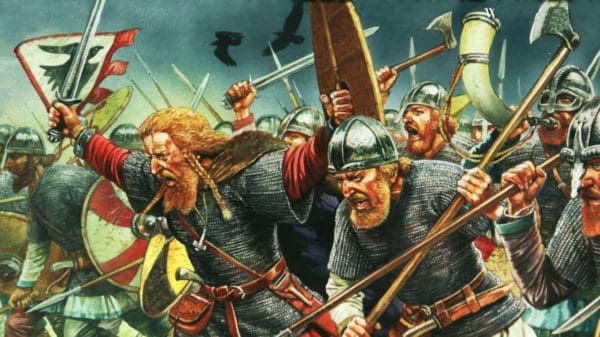Founded in the late 10th century, the Jomsvikings (Jomsborg Vikings) were a Scandinavian warrior brotherhood based at Jomsborg, a fortress on the southern Baltic shore (likely near modern Wollin, in German Pomerania). The Jomsvikings were an elite corps of mercenaries known for their bravery in battle, an intrepid warrior fraternity fully committed to Odin and Thor.
This legendary fraternity is surrounded by mysteries, with its origins often obscured by conflicting sources. One source states that this brotherhood was established and patronized by the Danish king, Harald Bluetooth. That Harald granted the leadership to Palnatoke (Toke the Archer), who received his nickname after he was forced to shoot an apple off of his own son’s head. Unlike William Tell, who shot at his stationary son, Palnatoke successfully did so as his son ran down a hill, a feat worthy of Ullr Himself.

Palnatoke may have a descendant at the Sherwood forest...
The Jómsvíkinga saga, however, claims that the group was founded by Palnatoke alone, with the land used to build the citadel of Jomsborg granted to him by the legendary Wendish ruler King Burislav.
Regardless of its uncertain origin, this Viking brotherhood soon became a force to be reckoned with in the Baltic. They intervened in dynastic disputes both in Sweden in 984, and in Norway in 986. In 1000, they fought with distinction at the battle of Svoldr, one of the greatest Battles of Viking Scandinavia.
The Jomsvikings drew their strength from adventure-seeking recruits from all over the Viking world (including Russ from Novgorod and Kiev). While their numbers are unknown to us, it is estimated that their ships numbered around 30, putting their strength at somewhere between 900 and 2,000 warriors. Alternative accounts put their numbers higher, at 300 and even an improbable 1000 ships; but these higher numbers may represent large fleets of allied Vikings who joined in for specific expeditions.
They lived by a strict code of conduct, with military discipline enforced among its members. Violation of these rules could be punished with immediate expulsion from the order.
Every member was a tested warrior and no man was accepted in the brotherhood without first having to prove his fighting prowess in a duel, or Holmgang, with another selected member.

Each Jomsviking was bound to defend his brothers, as well as to avenge their deaths if necessary. Speaking ill of one’s fellows and quarrellings between members were forbidden. Blood feuds between members were mediated by Jomsviking officers. No women or children were allowed within the fortress walls, and none were to be taken captive. (It is unclear, however, whether members were forbidden marriage or liaisons with women outside the walls.) No Jomsviking was permitted to be absent from Jomsborg for more than three days without permission.
Jomsvikings were forbidden to show fear or to flee in the face of an enemy of equal or inferior strength, though orderly retreat in the face of vastly outnumbering forces was acceptable. Finally, all spoils of battle were to be equally distributed among the entire brotherhood.
The most famous expedition of the Jomsvikings happened in 1009, under the command of Thorkell the Tall. The expedition arrived in Kent and proceeded to pillage and overrun most of the south of England, in one of the most extensive raids in history, culminating in the Siege of Canterbury in 1011 with the kidnapping and subsequent murder of archbishop Ælfheah (who had previously converted Norway King Olaf Tryggvason to christianity), in Greenwich on 19 April 1012.
After Thorkell defeated all the local forces encountered, he received a large payment (“danegild”) from King Æthelred the Unready, to cease raiding, the largest danegild ever recorded, with some sources rating the value at an astounding forty eight thousand pounds of silver, which were added to the already looted treasure and captives.

So much loot it is making us slow...
Jomsviking band soon split apart after that, undoubtedly due to the heavy lifting required to carry all that loot. Thorkell and some of this trusted men took a position into the English King Æthelred’s service. They were, after all, a mercenary company and English money was good. When Svein Forkbeard (king of Denmark from 986 to 1014) invaded the country, Thorkell’s band fought successfully for the English, driving back Svein’s forces.
The partnership was short-lived, as soon after the Jomsviking saved their new employer from the wrath of Svein Forkbeard, the English king Æthelred attacked them, forcing Thorkell and the survivors to return Denmark; now taking service with Svein (who they had just defeated).

Nothing personal…
When Svein’s son Cnut succeeded in conquering England in 1015, it was with the help of Thorkell and his Jomsviking warband. For this services, Thorkell was made Earl of East Anglia; and his band became the nucleus of Cnut’s household guards, the Huscarls.
The Jomsvikings’ power in the north declined rapidly after that. In 1043, Magnus I of Norway (nephew and co-king of Harald Hardrada) decided to that he couldn't tolerate such a powerful mercenary band. He sacked and destroyed the fortress of Jomsborg, putting an end to the last remaining members of the Jomsvikings.












